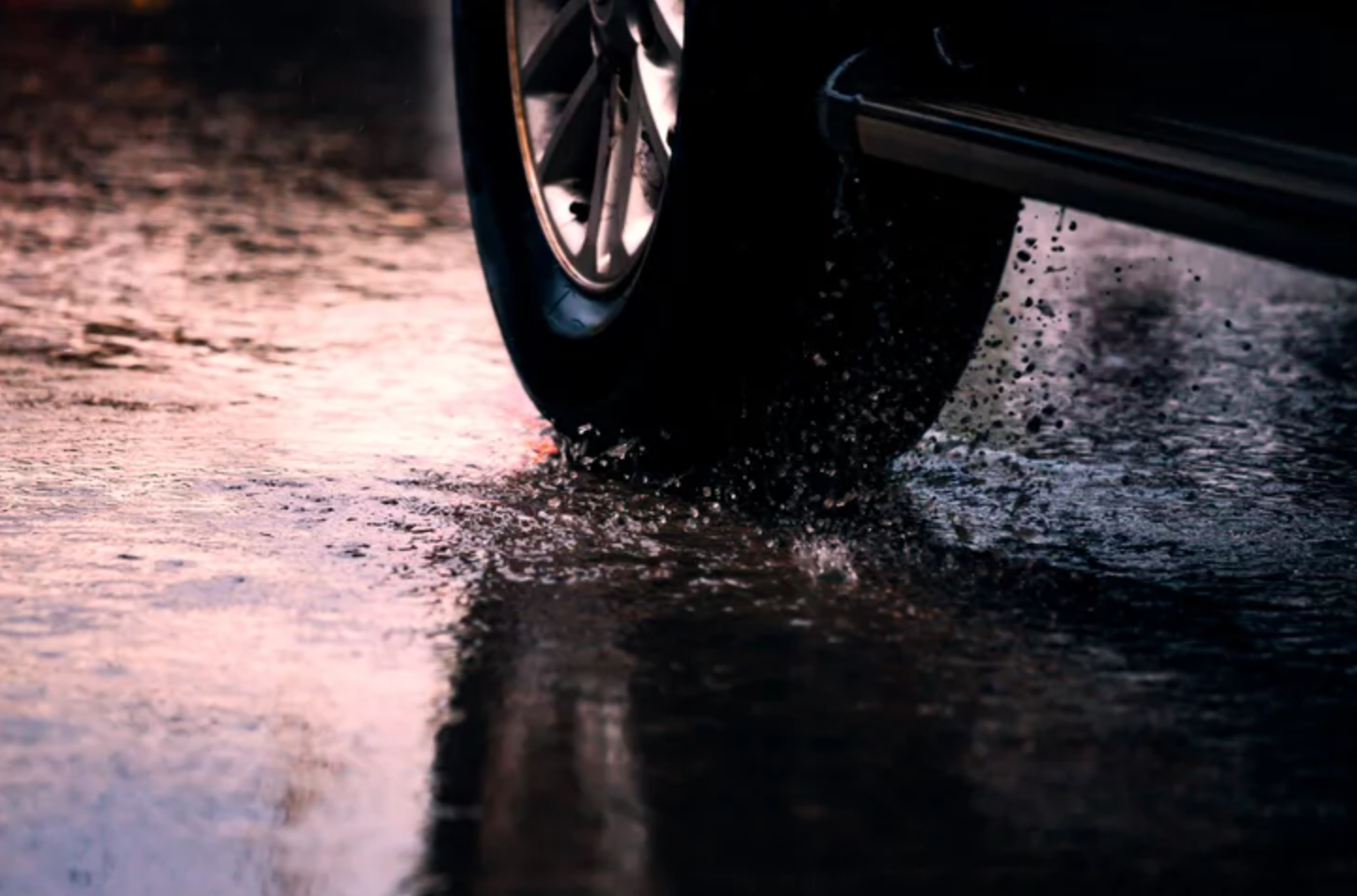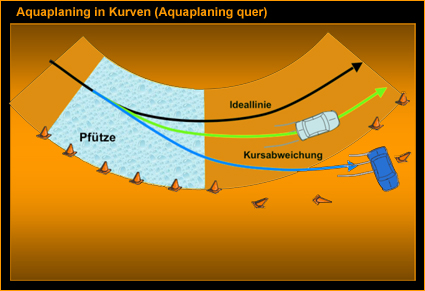Aquaplaning is when the tire floats on a layer of water. The vehicle can then no longer transmit any steering or braking forces.
The moment of floating depends on the speed, water level, tread depth and structure, air pressure and wheel load.
Because tires with low tread depth lose contact with the road even at low speeds, tire manufacturers and TÜV organizations recommend replacing tires not only at the 1.6 mm prescribed by law, but at a remaining tread of 2 mm. Wide tread grooves in the longitudinal and transverse direction of the tire significantly reduce the risk of aquaplaning.
Most motorists sooner or later become acquainted with aquaplaning. A loud noise from the tires. Suddenly the vehicle can no longer be steered. Lucky if this situation is survived accident-free. But what causes aquaplaning and how can it be prevented?

The causes of aquaplaning
Aquaplaning occurs in slush or rain. Put simply, the driver loses control when the tire can no longer absorb the water on the road. A film of water forms under the tire, which makes it impossible to steer the vehicle. A similar example would be when the human’s feet are in the air. There is no longer any way to react.
This sounds plausible, but aquaplaning depends on several factors.
- The speed: The higher the speed of the vehicle, the higher the risk.
- The water level on the streets: The driver can easily estimate from the water level whether there is a risk of aquaplaning.
- The tire profile: Such incidents can occur very quickly with worn tires. There is a much higher risk of accidents. Deep tire treads can usually absorb more water.
- The tire width: Narrower tires offer less contact surface for the water or slush. The wider a tire, the higher the risk. Of course, this also depends on the quality of the tire.
Other factors that can increase the risk of aquaplaning are the weight of the vehicle, tire pressure, road conditions, etc. You can also find out more here.

Respond correctly in the event of aquaplaning
Accidents often end in serious injuries. A number of drivers are suddenly surprised by aquaplaning. This effect can amplify the effect of misbehaving. In addition, simply ignorance can become a risk. There is a risk of aquaplaning from as little as 60 km/h. If the car begins to skid, the driver has little time to react properly. Not brakes! If the tires regain grip, there is a high probability that the vehicle will swerve and skid.
Always keep an eye on the street. No quick steering movements. Similar to braking, the recurring contact with the ground makes for terrible accidents. Keep the car on the road with a lot of feeling. It is important that the driver remains calm and keeps track.
The consequences of an accident can also serious consequences entail. If the speed is too high, the wrong tires etc., the insurance company will withdraw from its obligations. If other people are injured, a report of bodily harm must be expected.
Precautions against aquaplaning
The golden rules for safe driving in the rain are: adequate tire profile, correct air pressure (better 0.2 to 0.3 bar above the minimum air pressure specified by the car manufacturer), appropriate speed, sufficient distance to the vehicle in front, increased attention when visibility is poor and when it is raining. And another tip: Drivers are often surprised that the trucks hardly reduce their speed despite the rain. With heavy trucks, the phenomenon of aquaplaning does not exist due to the high weights or large masses. So don’t use the speed of the truck as a guide, it could catch your eye.
A danger for every driver
In the months of October, November and December, when heavy rain or light snowfall is often to be expected, drivers should pay attention to their tires. The quality also contributes a lot to minimizing the risk. tires with V profile are great for absorbing excess water. Every good tire manufacturer offers such models (more info here). However, there is no guarantee here either. The best solution is to pay attention to the water level on the road and slow down if necessary.
Drivers who want to protect themselves properly and want to improve their driving style for aquaplaning can complete an ADAC safety training course. In this training, drivers can quickly and correctly behave in situations.
How can I prevent aquaplaning?
Reduce speed and stay below 80 km/h.
Drive staggered on depressions in the road to get the tires out of the water.
On the sign spin danger pay attention and slow down.
Foot off the gas use to reduce speed. Don’t brake! This can intensify the aquaplaning effect.
No strong steering movement, the car often swerves, here only run very, very slowly. As soon as the car makes contact with the road again, you can really assess the change of direction.
What leads to aquaplaning?
Aquaplaning occurs when that water in front of the tire not draining fast enough. As a result, the water eventually slides under the tires and lifts the car off the road. This causes the driver to lose control of the vehicle. Worn tires displace the water badly and should be exchanged.
Where does aquaplaning occur most frequently?
– At ruts in the lane. For example, worn bus lanes often create a rut due to the weight.
– Road depressions, valleys & lower-lying sections of track. Rainwater and meltwater quickly collect there.
Where can I practice aquaplaning?
Driver training is available from the ADAC or on request from your insurance company. On a test site, the road is covered with water and you can practice how to behave.
How do I control my car while aquaplaning?
When driving on water, it’s important to take care to avoid aquaplaning. Here are some tips to help you stay safe while aquaplaning:
1. Take your foot off the accelerator gently.
If you’re driving at a high speed, your car will start to hydroplane (ski on the water) if you keep pressing on the gas. When this happens, you’ll lose control of your car and could end up in danger.
2. Keep the steering wheel straight.
If you’re steering your car while aquaplaning, you’ll need to keep it straight in order to avoid hitting objects or people. If your car starts to hydroplane, you may lose control and end up in danger.
3. Slow down to a safer speed.
If you find yourself in an aquaplaning situation, slow down to a safe speed and keep the car straight. Once you reach your safe speed, you can regain control of your car.
Tips on how to prevent aquaplaning
If you’re like most drivers, you probably think of aquaplaning as a dreaded occurrence that can happen to anyone at any time. But the truth is, aquaplaning is actually relatively rare, and can be avoided with some simple precautions.
To start, it’s important to drive smoothly and watch your speed. If you’re going too fast for the conditions, your car will struggle to stay on the road and you’ll risk aquaplaning.
Another important factor is checking your tyres every two weeks. Tyres that are worn out or have dried out can become slippery in wet weather, leading to aquaplaning.
Finally, it’s important to follow “tracks” in the road. When you’re driving in wet weather, your car will leave behind a pattern of water on the asphalt that other drivers can follow. This can help them stay safe and avoid aquaplaning.
If you do find yourself in a situation where you aquaplane, the best thing to do is to turn off cruise control and drive at a slower speed. Finally, don’t drive through puddles – they can be very dangerous!
Conclusion
Aquaplaning is a type of skidding that can happen when the water on the roadway creates a surface that is too slippery for the tires to grip. To prevent aquaplaning, drivers should stay alert and use caution when driving in wet conditions. Drivers can control their cars while aquaplaning by using the brakes and steering to stay on the curve of the road.
